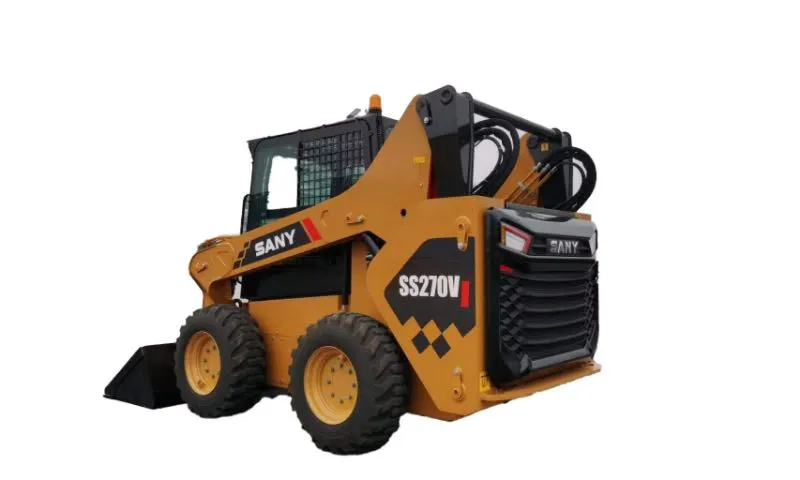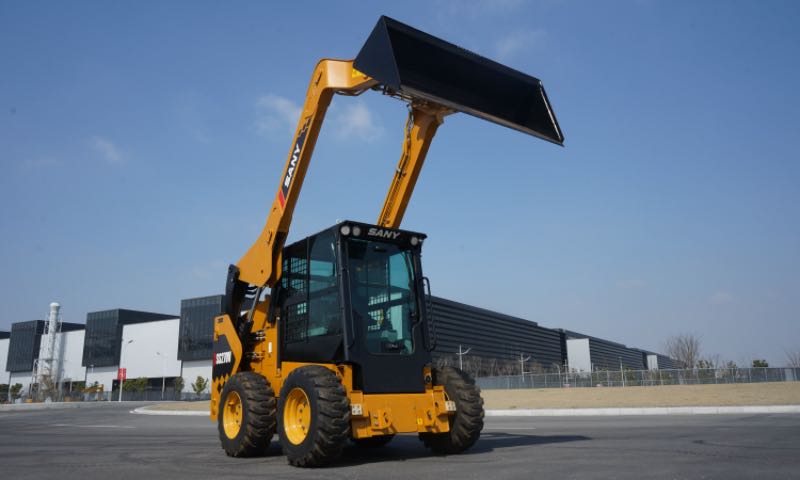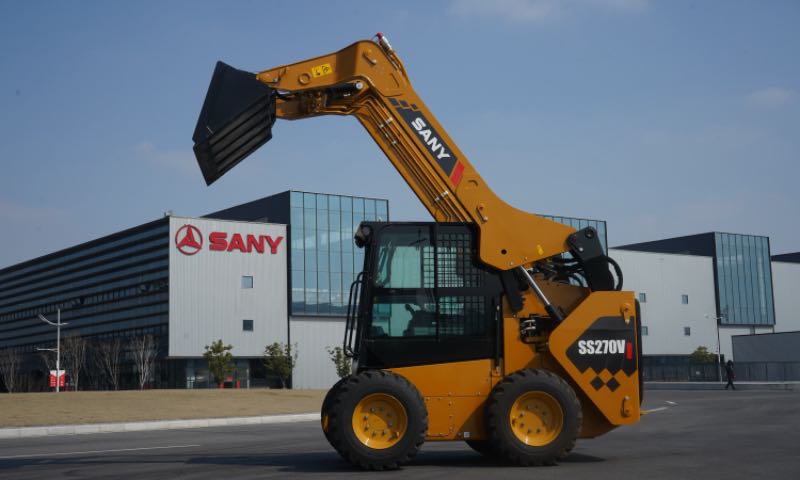What Is a Skid Steer Loader: A Comprehensive Guide to Sizes, Uses, and Selection
What is a skid steer loader? With skid steering and quick attachment changes, it boosts efficiency and cuts costs. This guide offers an in-depth analysis with practical tips.
A skid steer loader is an indispensable tool in the engineering field. With its unique skid-steer design and powerful versatility, it plays a vital role in municipal projects, agriculture, construction, and many other scenarios. In the following sections, we will take a closer look at what a skid steer loader is, its working principles, sizes, applications, and selection tips to help you choose the right machine.

What Is a Skid Steer Loader?
1. Definition
A skid steer loader is a compact wheeled construction machine with either no cab or a low-profile cab. Its small body allows it to operate in tight spaces that traditional loaders cannot access. By quickly switching attachments such as buckets, breakers, and other tools, it achieves “one machine, multiple functions.” Skid steers are commonly used in municipal maintenance, agriculture, small construction sites, and warehouse logistics.
2. Working Principle
The name “skid steer loader” comes from its unique skid-steering mechanism. Unlike traditional vehicles with a steering wheel and steering system, it turns by varying the wheel speeds on each side.
When turning left, the wheels on the left side slow down while the right-side wheels maintain their speed. This difference in wheel speed causes the machine to skid around the left wheels, completing the turn. This method—turning through wheel speed differences rather than steering wheels—is called “skid steering.”
3. Skid Steer Loader vs. Track Loader
Travel Method
Skid Steer Loader: Uses rubber tires, making it better suited for hard surfaces like concrete, asphalt, and factory floors. It moves faster and causes no damage to the ground.
Track Loader: Uses tracks, providing a greater ground contact area. This spreads the machine’s weight over a larger surface, improving traction and preventing sinking on muddy, rocky, or uneven terrains.
Steering Method
Skid Steer Loader: Has no traditional steering wheel. Instead, it relies on skid steering, which allows for an extremely small turning radius and excellent maneuverability in tight areas.
Track Loader: Uses a standard steering system with differential track control. However, it has a larger turning radius and bulkier body, making it unsuitable for confined spaces and better suited for large construction sites or mines.
Working Efficiency
Skid Steer Loader: Focused on small-scale, multi-functional operations. It adapts to different job sites by quickly switching attachments, making it ideal for varied, small-batch tasks.
Track Loader: Geared toward heavy-duty, large-scale operations. With a bigger bucket and stronger traction, it can move large amounts of earth and stone continuously. However, it has limited versatility, and changing attachments is less convenient, making it unsuitable for smaller, varied tasks.
Skid Steer Loader Sizes
The classification of skid steer loaders is primarily based on frame size, combined with three key factors: operating weight, horsepower, and rated operating capacity (ROC). They are typically divided into small, medium, and large models, each suited to different applications.
1. Small Skid Steer Loaders
Key Advantages: Lightest and most compact body, highly maneuverable, easy to transport, and capable of working in extremely tight spaces.
Applications: Narrow or confined spaces requiring precision, such as indoor demolition, underground projects, or landscaping. For example, small models are often the only option for demolition inside residential areas or material handling inside greenhouses.
2. Medium Skid Steer Loaders
Key Advantages: Balance between flexibility and power. Still relatively compact, but with more horsepower and ROC than small models. Capable of handling medium-intensity tasks and compatible with a wider range of attachments.
Applications: Tight spaces requiring medium-strength operations, such as excavation where larger machines cannot fit, small foundation digging, or municipal maintenance.
3. Large Skid Steer Loaders
Key Advantages: Highest horsepower, greatest ROC, and strongest working capacity among the three categories.
Applications: Heavy-duty tasks in open areas, such as large-scale demolition, earthmoving, or road construction. However, large skid steers are heavier, wider, and harder to transport, making them unsuitable for narrow spaces.

What Can You Do with a Skid Steer Loader?
1. Construction and Demolition
Excavation and Digging: With attachments like backhoes, augers, trenchers, or wheel saws, skid steers can perform tasks ranging from trenching to foundation excavation.
Demolition: Can handle both indoor jobs, like removing flooring or drywall, and outdoor tasks like demolishing small houses or walls by using demolition shears.
Grading and Backfilling: Buckets, rakes, or grading bars allow for surface leveling, filling pits, and clearing stones simultaneously.
2. Municipal and Road Work
Road Construction and Maintenance: With a cement mixer attachment, skid steers can mix small batches of concrete on-site. Pavement planers help remove old road surfaces, while other tools prepare foundations or repair damaged pavement.
Snow and Debris Removal: Standard buckets can remove snow, branches, and construction debris. For larger-scale snow clearing, snow blowers or snowplow blades are far more efficient than manual labor or small snow machines.
3. Agriculture and Landscaping
Agriculture: Tasks include cleaning barns with a bucket, moving hay bales with hay spear attachments, and preparing soil with tillers by mixing fertilizer or compost.
Landscaping: Skid steers can grind stumps with stump grinders, transport gravel or mulch with buckets, and mow tall grass or cut small trees with rotary cutters, helping create a clean and organized landscape.
4. Material Handling and Warehousing
Construction Material Handling: Buckets can transport sand, cement bags, or tools around a job site.
Warehouse Material Handling: With pallet fork attachments, skid steers function like forklifts, ideal for small to medium warehouses where they can maneuver between racks to load and unload pallets.
How to Choose the Right Skid Steer?
Selecting the right skid steer loader requires evaluating three core factors—work space, specific tasks, and jobsite terrain—along with key performance parameters of the equipment.
1. Work Space
Tight spaces, such as indoor projects, tunnels, or greenhouses, call for compact models. These machines have narrower bodies and smaller turning radii, allowing them to maneuver flexibly without damaging nearby structures.
Open spaces such as large construction sites or roadwork areas are better suited for medium to large models. Although bigger in size, these machines deliver higher efficiency and can handle more intensive tasks.
2. Specific Tasks
Different jobs demand different levels of lifting capacity, operating load, and horsepower. It’s essential to match equipment specs with task requirements. For example:
For shallow digging or light material handling, choose models with a lower rated operating capacity (ROC) and lift height.
For heavy-duty excavation or moving compacted soil, opt for models with higher ROC and horsepower.
3. Jobsite Terrain
Hard surfaces like concrete, asphalt, or warehouse floors are ideal for wheeled skid steer loaders. They travel quickly, experience less wear, and don’t damage paved surfaces, making them suitable for municipal maintenance, indoor work, or warehouse operations.
Soft or uneven terrain requires track loaders. Tracks provide a larger ground contact area, lower ground pressure, and stronger traction, reducing the risk of getting stuck. They perform well in agriculture, hillside projects, or muddy post-rain construction sites.
What Is the Best Skid Steer Loader?
The SANY Skid Steer Loader features a vertical lift design, high dumping height, dual-speed configuration, and quick cycle times for fast and efficient performance. It supports a wide range of attachments, including buckets, sweepers, snow removal tools, planers, and augers, making it adaptable for various jobs. The cab is spacious, well-sealed, and designed with low noise levels, providing operators with a comfortable working experience.

Should You Rent or Buy a Skid Steer Loader?
1. When Renting Makes Sense
Low usage frequency or short-term needs: If the machine is only used occasionally, renting is more cost-effective. Frequent rentals may still cost less than a one-time purchase, while avoiding depreciation when equipment sits idle.
Need flexibility with models or attachments: Different projects may require different specifications. Renting allows you to select the right machine for each job, while specialized attachments can be rented to avoid buying tools you rarely use.
Avoid maintenance and transport hassle: Rental companies usually cover daily servicing and repairs. For remote projects, you can rent locally to save on transportation costs and risks.
Limited budget: Buying requires a large upfront investment, while renting involves only periodic payments, reducing short-term financial pressure. This is ideal for small businesses, independent contractors, or startups.
2. When Buying Makes Sense
High usage frequency: If the machine is needed regularly or has become essential to daily operations, owning is more cost-effective over time and avoids delays caused by rental shortages.
Need reliable, long-term use: Purchased equipment is always available, can be configured to your specific requirements, and eliminates downtime waiting for rentals.
Fixed set of attachments: If your work relies on the same attachments, purchasing both the loader and core tools offers better value and long-term efficiency.
Focus on long-term ROI: While the upfront cost is higher, skid steer loaders have lower purchase and maintenance costs compared to other heavy equipment. Ownership also allows you to resell used equipment later, recovering part of your investment and maximizing long-term value.
Conclusion
This article provides a detailed explanation of what a skid steer loader is and offers practical guidance for daily selection, rental, or purchase, aiming to help more operators handle complex job sites with ease and improve overall efficiency.
FAQs
Why do they call it a skid steer?
Skid steer loaders are called “skid steers” because they do not use a traditional steering wheel or steering mechanism. Instead, the wheels remain fixed at a straight angle, and the machine turns by varying the speed of the wheels on each side. This difference in speed causes the machine to skid and pivot, a process known as “skid steering.”
What is a skid steer loader used for?
A skid steer loader relies on its flexible skid steering and interchangeable attachments to perform a wide range of tasks, especially in tight spaces. In construction, it can handle demolition, digging, and material transport. In municipal work, it is used for road maintenance and snow removal. In landscaping, it is ideal for grading, land clearing, and stump grinding.
What is the difference between a skid steer and a loader?
“Loader” is a general term that includes various types of machines, such as skid steer loaders and track loaders. A skid steer loader, however, is a specific type of loader known for its compact frame and skid steering mechanism, allowing it to operate efficiently in confined areas. It also supports rapid attachment changes, making it a versatile multi-purpose machine.
How wide is a skid steer loader?
The size of a skid steer loader varies depending on the model and manufacturer. Typically, a skid steer loader ranges from 36 to 84 inches wide, 6 to 12 feet long, and 6 to 7.5 feet high. Compact models are best suited for working in tight spaces, while larger units provide extended reach and power for heavy-duty applications.
What is the tipping load on a skid steer?
The tipping load refers to the maximum weight a skid steer loader can safely carry before it reaches the point of tipping forward. It is a critical measure of stability and helps operators understand the machine’s limits to ensure safe and effective operation.
How to load a skid steer on a trailer?
1. Choose the right equipment and site: Select a trailer with a suitable length and load capacity, equipped with sturdy ramps. Ensure the site is level and open.
2. Inspect equipment condition: Check both the skid steer loader and the trailer for faults. Confirm that brakes and steering are functioning properly.
3. Secure the ramps: Attach the ramps firmly to the trailer at the proper angle. Use wheel chocks if needed to prevent shifting.
4. Drive the loader onto the trailer: Start the skid steer loader, approach the ramp slowly, and drive straight at low speed. Once on the trailer, stop gently at the designated position.
5. Secure the loader: Use heavy-duty straps, chains, or tie-downs to lock the wheels or frame to the trailer, ensuring stability during transport.



